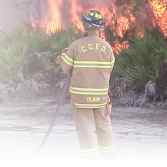|

Since 1998, more than 15,000 wildland fires have devastated 1 million acres of Florida's landscape and destroyed more than 750 structures. The physical damage alone is difficult to calculate, let alone the emotional trauma.
Wildfire destruction has taken center stage in our state due to rapid population growth in the wildland-urban interface. The interface is the area where homes and subdivisions border or mix into the wooded lands. Wildfires spread rapidly into these areas burning homes and other structures.
Florida's long-term drought conditions have caused more wildland fires. This weather phenomenon has created a dry environment for wildfires to rapidly spread, rather than be limited or quickly controlled. And with more people choosing to live in or near wooded areas, firefighters spend much more time protecting homes and families rather than controlling wildland fires. Additionally, Florida's record-number of thunderstorms and lightning events create hundreds of new wildfire starts each year.
"Firewise" is a new educational program to help the public understand more about what they can do to protect their property from future wildfire strikes. This program is coordinated through the Florida Division of Forestry and the Department of Community Affairs, Division of Emergency Management, in cooperation with the National Wildland Coordinating Group and the National Fire Protection Association.
The Firewise web site can be found on the Internet at: www.firewise.org. Information is also available from local Florida Division of Forestry offices or the Florida Division of Emergency Management
|